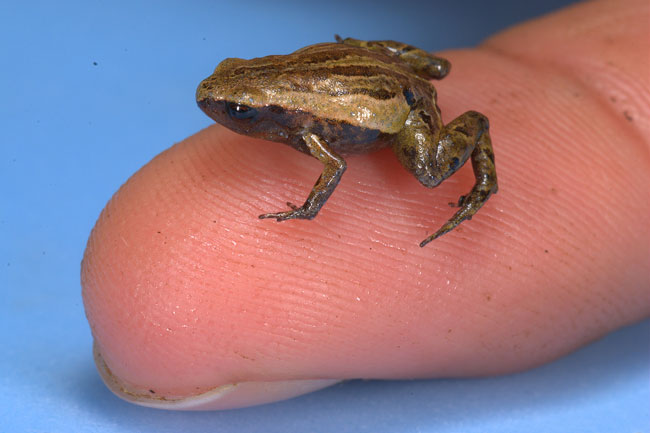Tiny Newfound Frog Fits on a Fingertip

A tiny, "midget" frog that can fit on the tip of a finger — and previously only known by its croaking — has finally been found by researchers.
The frog, dubbed Noble’s Pygmy frog (Noblella pygmaea), is the smallest ever found in the Andes and one of the tiniest amphibians in the world.
The amphibian, with an average length of about 0.45 inches (11.4 millimeters) and an unusually long forefinger, was discovered during field work in the highlands of Peru's Manu National Park.
The frog wasn't hard to spot solely because of its small size — its brown color keeps it well camouflaged. But locals helped a team of German and Peruvian herpetologists catch their first glimpse of the creature
Noblella pygmaea inhabits the cloud forest, the montane scrub and the high-elevation grasslands at an altitude from about 9,900 to 10,500 feet (3025 to 3190 meters) above sea level in and around the park.
The females of the species lay only two eggs that are about 4 millimeters in diameter. Unlike the eggs of most amphibian species, these are laid in moist, terrestrial microhabitats, such as in moss or leaf litter, and are protected from insect predators by the mother frog.
Also unusual is that the embryos don't change into tadpoles, but instead lead a fully terrestrial life immediately after hatching.
Get the world’s most fascinating discoveries delivered straight to your inbox.
Because Manu National Park is a well known biological “hotspot," the scientists that conducted the study, Edgar Lehr of the Senckenberg Natural History Collection Dresden in Germany and Alessandro Catenazzi of the University of California at Berkeley, think that Noblella pygmaea is only one of many undiscovered amphibians in the Andes mountain area. The discovery of Noblella was detailed in the February 2009 issue of the journal Copeia.
Despite living in a nominally protected area, global warming, other human-caused changes to the habitat and the virulent, epidemic fungus Batrachochytrium dendrobatidis, threaten amphibians of the Andean region.
Fortunately, the fungus has not been noticed on Noblella so far. Its terrestrial lifestyle may mean the frog is less exposed to the fungus than stream-dwelling frogs.
- Frogs News, Images and Information
- 10 Amazing Things You Didn't Know About Animals
- Images: Amphibian Tree of Life



